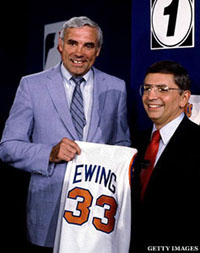The Truth Is Out There: From The 1985 NBA Draft Lottery To The Olympics To Game-Fixing … Which Conspiracy Theory Can You Believe?
by Patrick Hruby
The Post Game
May 30, 2012
“You know,” says the magician, “it’s very easy to fix flipping a coin.” For instance: The tosses before football games. Turns out they’re totally riggable. Even with a straight coin. Con men know how. So does the magician, Richard Kaufman. He’s in his 50s, has dark, curly hair, works as the editor of Genii, the nation’s leading magic magazine. Specializes in card tricks. Only now, here in the sunlit kitchen of his suburban Washington, D.C. home, he’s talking tumbling coins.
Heads or tails. Even odds. As indifferent as the universe itself, like the flips that sent Lew Alcindor to the Milwaukee Bucks, Bill Walton to the Portland Trail Blazers, Ralph Sampson and Hakeem Olajuwon to the Houston Rockets.
Unless …
“See, when you flip in the air, you can get the toss location like this,” Kaufman explains, losing me with a single, rapid hand flourish. “Heads side always to the left. Tails side to the right. It looks like it’s spinning. But it’s not. It’s a true illusion.”
 I came here for illusions. To look right past them. To spot the sinister, hidden hand behind the not-so-random workings of the sports world. Specifically, I came to have Kaufman watch grainy, digitized footage of the 1985 NBA Draft Lottery — the Zapruder film of athletic conspiracies — and then tell me how commissioner David Stern managed to rig the whole damn thing.
I came here for illusions. To look right past them. To spot the sinister, hidden hand behind the not-so-random workings of the sports world. Specifically, I came to have Kaufman watch grainy, digitized footage of the 1985 NBA Draft Lottery — the Zapruder film of athletic conspiracies — and then tell me how commissioner David Stern managed to rig the whole damn thing.
I am not crazy.[1]
OK, sure: Maybe I’ve watched the ’85 lottery so many times I can identify the key co-conspirators by tie color alone.[2]
Maybe I know exactly how many envelopes accounting firm partner Jack Wagner conspicuously bangs against the side of the clear plastic drawing cylinder. (One, and only one.) Maybe I’ve committed to memory the precise moments when Stern appears to thumb the bent corner of the winning envelope he’s plucked from the cylinder, after grabbing and flipping and discarding two others. Maybe I can tell you that upon exposure to room temperature of 70 degrees, a plain manila envelope stored in a home freezer remains cold to the touch for 52.3 seconds.
None of this makes me crazy.
No, a crazy person would accept the lottery at face value. A crazy person would review the entire fortuitous chain of events[3] that produced Patrick Ewing, New York Knickerbocker, and chalk everything up to dumb luck. Coincidence, even.
A sane person doesn’t believe in coincidence.
A sane person believes in causation. Connects the jumbled dots. Creates an octopus chart linking Stern to the Knicks’ Dave DeBusschere to Rod Thorn to Si Green to John Thompson to Ewing.[4]
A sane person knows that if a coin flip can be fixed, then anything[5] can be fixed, that all it takes is motive and opportunity, people who can be trusted not to talk, and a public content to not ask questions, because asking questions and peeking behind the curtain and stuffing test envelopes between your ice maker and frozen fish sticks is … crazy.
Or so they want us to believe.
Yes, a sane person forsakes the official, obligatory NBA denials and instead screens the ’85 lottery with a magician, because magicians know smoke and mirrors when they see them. (A sane person thinks the 1993 Draft Lottery [6] was a bit sketchy, too.)
Kaufman peers at my laptop. We’re sitting at his kitchen table, draped by a yellow-and-tan cloth. It’s a lovely afternoon; outside, a flower garden blooms. Kaufman has been performing card tricks since he was 12, wrote his first magic book at 14, has written or illustrated 20 books since. He has edited and co-owned Genii for a decade, traveled around the world for magic shows and conventions. In other words: if there’s a trick Kaufman hasn’t seen, it probably has yet to be invented.
Read the rest of this article (including the numbered notes) here.


